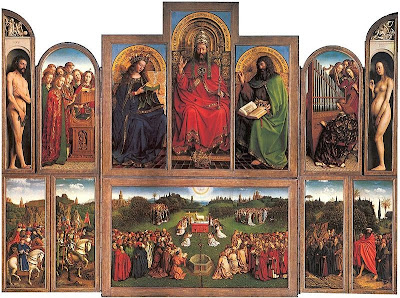 |
|
The Tower of Babel, Pieter Bruegel the Elder, c. 1563
|
From: “Hunter College Art & Art History Department”
Date: May 21, 2015 at 2:33:12 PM EDT
Date: May 21, 2015 at 2:33:12 PM EDT
To: undisclosed-recipients:
Subject: Course Updates: Renaissance Art and Art of Africa
Dear all,
Unfortunately “Renaissance Art I” has been cancelled. If you are one of those preregistered for this course, please get in touch with me asap so that we can find you a replacement.
And on a more positive note: the “Art of Africa” course will be taught by Dr. Gary van Wyk. Please see the description, below. Again, email if you would like to enroll in this course.
 |
|
St. Mark Preaching in Alexandria, Giovanni Bellini, 1504-07
|
That note was received yesterday by a Hunter College MA candidate in Art History. Whatever the relative merits of African vs. Renaissance art, the latter is fundamental, not just for art historians, but for literate citizens of the western world in general.
 |
|
The School of Athens, Raphael, 1510
|
This gap is not just about a class: if there is no Renaissance painting class being offered at the graduate school, there is nobody to advise a student in writing his or her thesis. That means Renaissance painting is effectively off the table as a concentration. In turn, that student is at a disadvantage in seeking work focusing on Renaissance art.
“The course will explore post-colonial and postmodern positions on Africa in the art world, with special focus on the School of Dakar and the Negritude movement (Senegal), the Nsukka School (Nigeria), and the Resistance Art Movement in South Africa,” reads the course description for Dr. van Wyk’s class. “The course will consider contemporary artistic and curatorial practices that re-frame Africanity in today’s global context, including the current Venice Biennale, curated by Okwui Enwezor.”
In Manhattan’s art world, Renaissance art dwarfs any contemporary African collections. Hunter is setting its students up for irrelevancy in the very job market in which it is located, which is also the most important art market in this country.
But there is another problem here, common to public universities. Required classes are often not available, leading kids to take longer to finish degrees.
 |
|
The Ghent Altarpiece, Jan van Eyck, c. 1432
|
While about 80 percent of undergraduates earning degrees at private colleges and universities finish within four years, at public institutions the rate drops to 50 percent.
That can make a public school education less of a good deal compared to private colleges. Not only must the student shell out more tuition than originally anticipated, he or she loses a year of earnings in the bargain.
 |
|
Christ Handing the Keys to St. Peter, Pietro Perugino, 1481
|
Let me know if you’re interested in painting with me on the Schoodic Peninsula in beautiful Acadia National Park in August 2015. Click here for more information on my Maine workshops! Download a brochure here.
